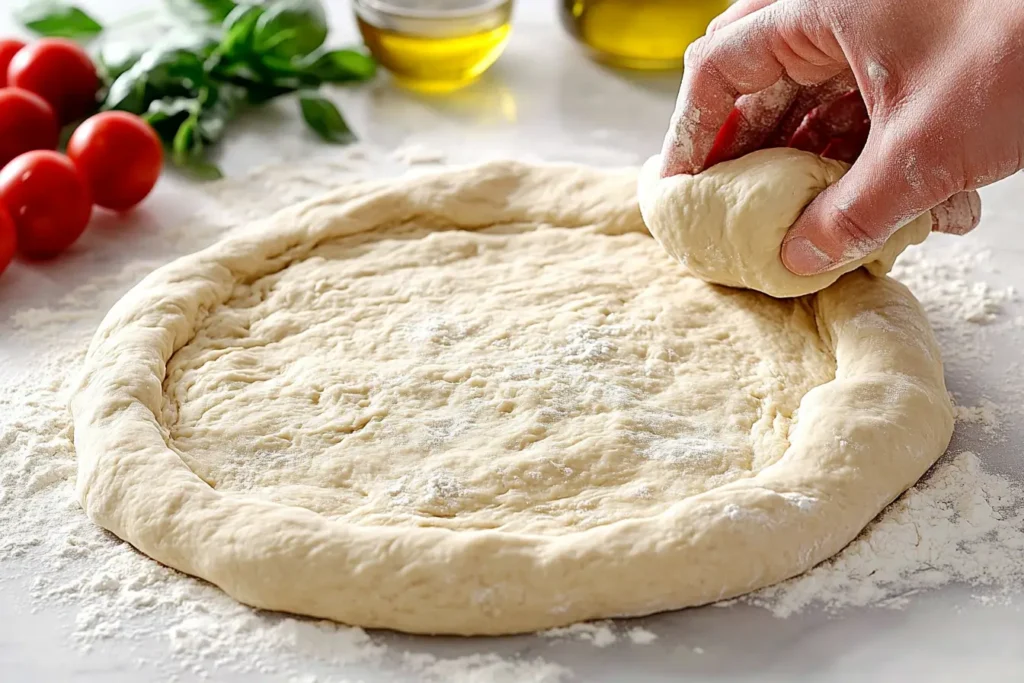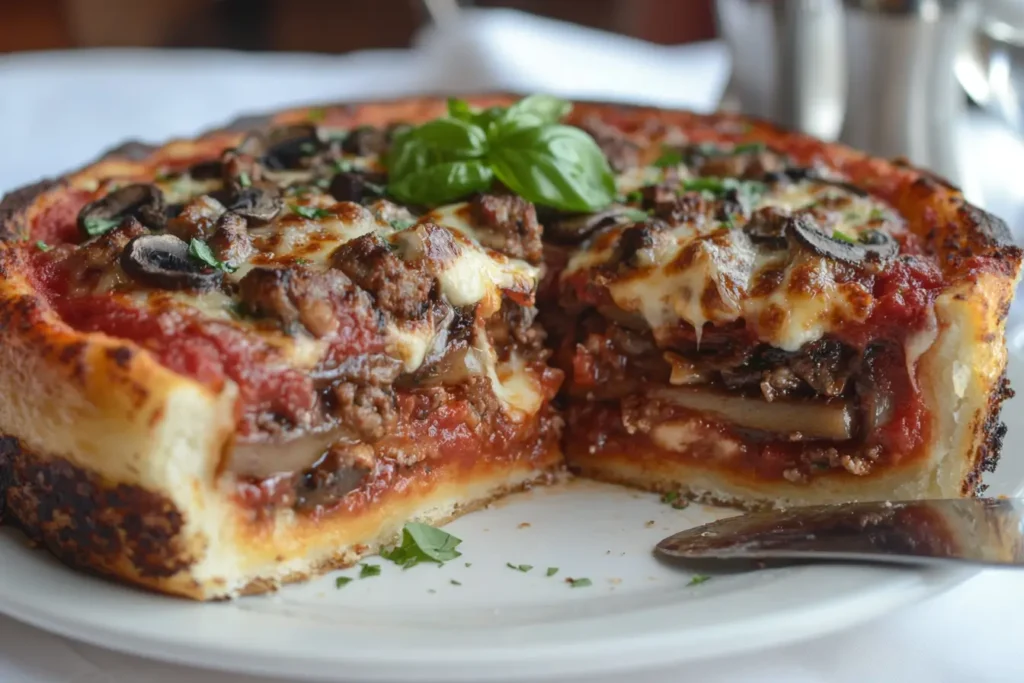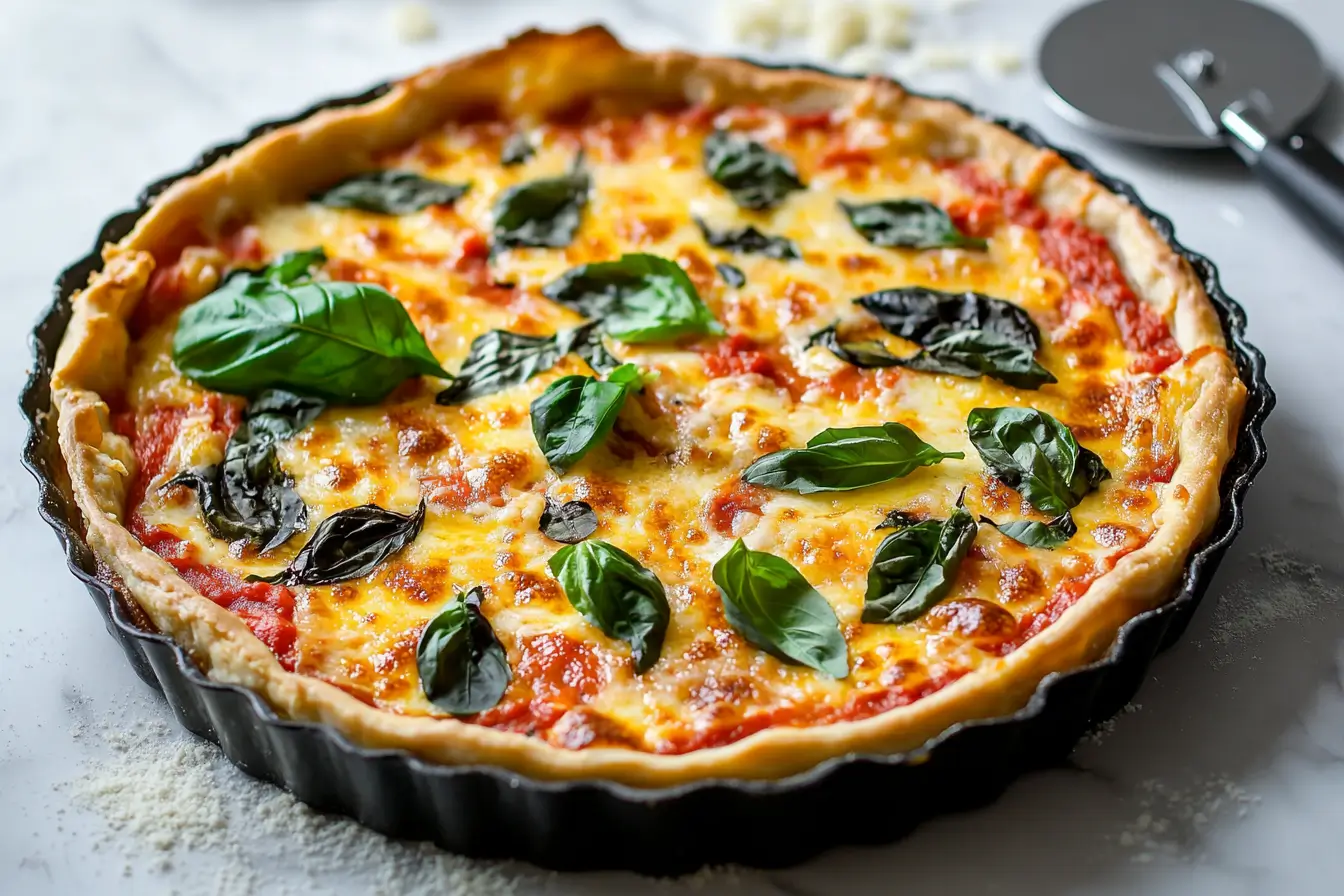Making a delicious pizza pie at home can be easier than you think! This Pizza Pie Recipe guides you through creating a classic pizza that’s perfect for any occasion. Whether it’s a quick weeknight meal or a fun weekend gathering, this recipe is adaptable to your schedule and everyone’s taste buds. From homemade dough to a flavorful sauce, we’ll cover everything you need to know.
This recipe is designed to be flexible. Beginners can follow the simple instructions, while more experienced cooks can customize the toppings and experiment with different flavor combinations. If you’re looking for other delicious dinner options, check out this Slow Cooker Cheesy Ravioli Bake. Get ready to create a pizza pie everyone will love!
Why this Pizza Pie Recipe is Special
This Pizza Pie Recipe is unique because it emphasizes both flavor and simplicity. The homemade dough is surprisingly easy to make, and the sauce is incredibly versatile. You can adjust the seasonings to your liking and add your favorite toppings. It’s the perfect canvas for creating your dream pizza! For some inspiration, you might enjoy this Burger Bowl Recipe Guide for a different take on customizable meals.
Ingredients
This Pizza Pie Recipe is divided into three parts: the dough, the sauce, and the toppings. Gather these ingredients before you begin.
For the Dough
-
1 cup warm water (105-115°F)
-
2 teaspoons active dry yeast
-
1 teaspoon sugar (optional, for yeast activation)
-
2 tablespoons olive oil
-
2 1/2 cups all-purpose flour, plus more for dusting
-
1 teaspoon salt
For the Sauce
-
1 (28-ounce) can crushed tomatoes
-
2 cloves garlic, minced
-
1 teaspoon dried oregano
-
1/2 teaspoon dried basil
-
1/2 teaspoon salt
-
1/4 teaspoon black pepper
Topping Suggestions
The best part about pizza is choosing your favorite toppings! Here are some ideas to get you started:
-
Classic: Pepperoni, mozzarella cheese, mushrooms, onions, green bell peppers
-
Veggie Lovers: Mushrooms, onions, green bell peppers, black olives, spinach, tomatoes
-
Meat Lovers: Pepperoni, sausage, bacon, ham
-
Gourmet: Roasted red peppers, artichoke hearts, feta cheese, fresh basil
Making the Pizza Dough
Making pizza dough from scratch is easier than you might think! Follow these simple steps:
Activating the Yeast
In a large bowl, combine the warm water and yeast. The water should be between 105-115°F. Too hot, and you’ll kill the yeast; too cold, and it won’t activate. Add the sugar (if using), which helps the yeast get going. Let the mixture stand for 5-10 minutes. You should see a foamy layer on top, indicating that the yeast is active. If your yeast doesn’t foam, it might be old. Try again with a fresh packet of yeast. Looking for more bread recipes? Check out this Sourdough Bread Guide.
Kneading the Dough
Add the olive oil, salt, and two cups of flour to the yeast mixture. Stir with a wooden spoon until a shaggy dough forms. Turn the dough out onto a lightly floured surface and knead for 5-7 minutes, adding more flour as needed, until the dough is smooth and elastic. If using a stand mixer, use the dough hook attachment and knead on low speed for about the same amount of time. The dough should be slightly tacky but not stick to your hands.
Proofing the Dough
Lightly grease a large bowl with olive oil. Place the dough in the bowl, turning to coat it with oil. Cover the bowl with plastic wrap or a clean kitchen towel. Let the dough rise in a warm place for 1-1.5 hours, or until doubled in size. A good tip is to place the bowl in a slightly warmed (but turned off) oven. This creates a warm, draft-free environment. You’ll know the dough is ready when it springs back slowly after you gently poke it with your finger. For another delicious dough-based recipe, try these Pastelitos.

Making the Pizza Sauce
While you can use store-bought pizza sauce, homemade sauce is so much tastier! This article on healthy pizza recipes offers some great insights into creating nutritious and flavorful pizzas.
Simmering the Sauce
In a medium saucepan, combine the crushed tomatoes, minced garlic, oregano, basil, salt, and pepper. Bring the sauce to a simmer over medium heat. Then, reduce the heat to low and let it simmer uncovered for at least 15 minutes, or up to 30 minutes for a richer flavor. Stir occasionally to prevent sticking. Low heat is key here; it allows the flavors to meld without scorching the sauce. If you enjoy making sauces from scratch, you might also like this White Gravy Recipe.
Flavoring the Sauce
Taste the sauce and adjust the seasonings as needed. If you like a sweeter sauce, add a pinch of sugar. For extra depth, consider adding a pinch of red pepper flakes or a dash of balsamic vinegar. Fresh herbs like parsley or oregano can be added at the end of simmering for a bright, herby flavor. Remember, this is your pizza, so feel free to experiment and create a sauce that you love!
Assembling and Baking the Pizza Pie
Now for the fun part – assembling your pizza!
Preparing the Oven and Baking Surface
Preheat your oven to 450°F (232°C). If you have a pizza stone, place it in the oven while preheating. A pizza stone helps create a crispy crust. If you don’t have a pizza stone, a baking sheet will work just fine. Lightly grease the baking sheet or pizza peel (if using a pizza stone) with olive oil or cornmeal to prevent sticking.
Shaping the Dough
Punch down the proofed dough to release the air. On a lightly floured surface, shape the dough into a round crust. You can do this by hand-stretching, gently pulling and rotating the dough. Alternatively, use a rolling pin to roll it out to your desired thickness. Aim for about 1/4 inch thick for a classic crust.
Adding the Sauce and Toppings
Spread the pizza sauce evenly over the dough, leaving about a 1/2-inch border for the crust. Sprinkle with mozzarella cheese, then add your desired toppings. Don’t overload the pizza with toppings, as this can make the crust soggy. Want to try something different? This Pickle Pie Pizza recipe might surprise you!
Baking the Pizza
Carefully transfer the pizza to the preheated oven. If using a pizza stone, slide the pizza onto the hot stone using a pizza peel. Bake for 12-15 minutes, or until the crust is golden brown and the cheese is melted and bubbly. For a crispier crust, bake for a few extra minutes. Let the pizza cool slightly before slicing and serving. If you enjoy experimenting with different baking methods, you could try these Air Fryer Biscuits.

FAQ
Here are answers to some commonly asked questions about pizza pie:
What are the ingredients of pizza pie?
The basic ingredients of a pizza pie are dough (made from flour, yeast, water, and salt), tomato sauce, cheese, and your choice of toppings. This recipe uses simple ingredients for both the dough and the sauce, making it easy to create a delicious pizza from scratch.
What’s the difference between pizza and pizza pie?
“Pizza” and “pizza pie” are generally the same thing. The term “pizza pie” is more common in some parts of the United States, possibly because of the round shape and the way it’s sliced and served, much like a pie. You can learn more about this here.
How do I cook my pie pizza?
Pie pizza, or simply pizza, is typically cooked in a hot oven, usually between 450-500°F. The exact baking time depends on your oven and how thick your crust is. This Pizza Pie Recipe gives specific instructions for baking times and temperatures to help you get the perfect results.
Can pizza dough be used for pies?
Pizza dough can be used for certain kinds of pies, especially savory ones. For example, you could use it for calzones, which are folded-over pizzas, or hand pies. Because pizza dough is yeasted, it has a different texture than regular pie crust. It will be chewier and less flaky. Pizza dough isn’t usually used for sweet pies because it has a savory flavor.
Serving and Storing
Here are some tips for serving and storing your delicious pizza pie:
Serving Suggestions
Freshly baked pizza is best served hot! Slice it into wedges and serve immediately. Pizza is great on its own, but you can also pair it with a simple salad or some breadsticks. For beverages, classic choices include soda, iced tea, or even beer for the adults. If you’re feeling adventurous, try pairing your pizza with a crisp white wine like Pinot Grigio. For another great Italian-inspired dish, check out this Creamy Parmesan Italian Sausage Soup.
Storing Leftovers
If you have leftover pizza, store it in an airtight container in the refrigerator. It will stay fresh for 3-4 days. To reheat, you can microwave it for a quick fix, but for a crispier crust, reheat slices in a skillet over medium heat, or in a toaster oven. You can even reheat it in the oven at 350°F for a few minutes until warmed through. Looking for ideas on using leftover chicken? Check out these Leftover Rotisserie Chicken Recipes.
Conclusion
Making pizza at home is a fun and rewarding experience. This Pizza Pie Recipe is a great starting point, but don’t be afraid to get creative! Experiment with different toppings, try new sauce combinations, and make it your own. Sharing a homemade pizza with family and friends is a special way to create lasting memories. Enjoy the delicious aroma filling your kitchen and the satisfaction of creating something truly special from scratch.

